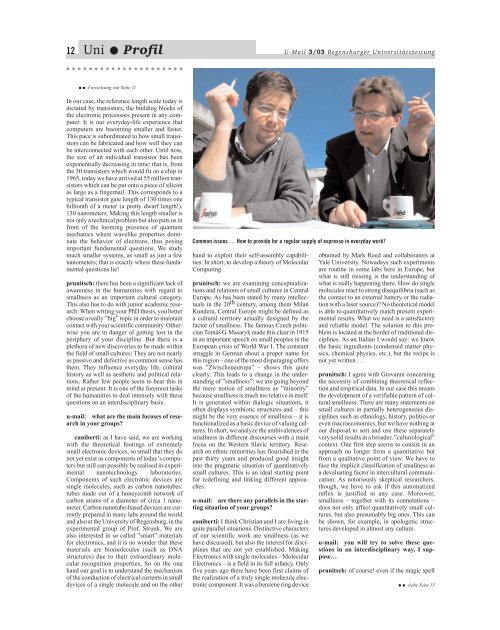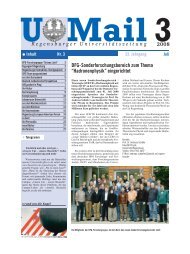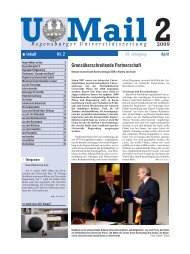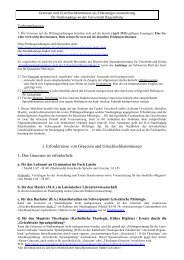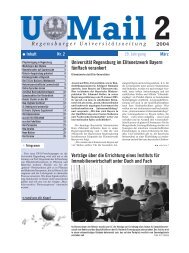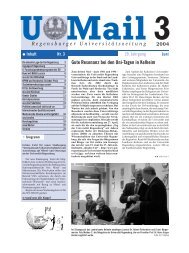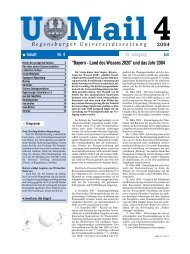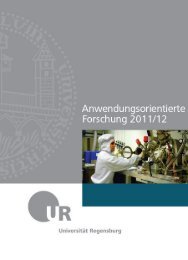Neuer Meilenstein in der Geschichte des Klinikums
Neuer Meilenstein in der Geschichte des Klinikums
Neuer Meilenstein in der Geschichte des Klinikums
Erfolgreiche ePaper selbst erstellen
Machen Sie aus Ihren PDF Publikationen ein blätterbares Flipbook mit unserer einzigartigen Google optimierten e-Paper Software.
12<br />
••<br />
Uni Profil U-Mail 3/03 Regensburger Universitätszeitung<br />
Fortsetzung von Seite 11<br />
In our case, the reference length scale today is<br />
dictated by transistors, the build<strong>in</strong>g blocks of<br />
the electronic processors present <strong>in</strong> any computer.<br />
It is our everyday-life experience that<br />
computers are becom<strong>in</strong>g smaller and faster.<br />
This pace is subord<strong>in</strong>ated to how small transistors<br />
can be fabricated and how well they can<br />
be <strong>in</strong>terconnected with each other. Until now,<br />
the size of an <strong>in</strong>dividual transistor has been<br />
exponentially decreas<strong>in</strong>g <strong>in</strong> time: that is, from<br />
the 30 transistors which would fit on a chip <strong>in</strong><br />
1965, today we have arrived at 55 million transistors<br />
which can be put onto a piece of silicon<br />
as large as a f<strong>in</strong>gernail. This corresponds to a<br />
typical transistor gate length of 130 times one<br />
billionth of a meter (a pretty dwarf length!),<br />
130 nanometers. Mak<strong>in</strong>g this length smaller is<br />
not only a technical problem but also puts us <strong>in</strong><br />
front of the loom<strong>in</strong>g presence of quantum<br />
mechanics where wavelike properties dom<strong>in</strong>ate<br />
the behavior of electrons, thus pos<strong>in</strong>g<br />
important fundamental questions. We study<br />
much smaller systems, as small as just a few<br />
nanometers; that is exactly where these fundamental<br />
questions lie!<br />
prunitsch: there has been a significant lack of<br />
awareness <strong>in</strong> the humanities with regard to<br />
smallness as an important cultural category.<br />
This also has to do with junior academic research:<br />
When writ<strong>in</strong>g your PhD thesis, you better<br />
choose a really ”big” topic <strong>in</strong> or<strong>der</strong> to ma<strong>in</strong>ta<strong>in</strong><br />
contact with your scientific community. Otherwise<br />
you are <strong>in</strong> danger of gett<strong>in</strong>g lost <strong>in</strong> the<br />
periphery of your discipl<strong>in</strong>e. But there is a<br />
plethora of new discoveries to be made with<strong>in</strong><br />
the field of small cultures: They are not nearly<br />
as passive and defective as common sense has<br />
them. They <strong>in</strong>fluence everyday life, cultural<br />
history as well as aesthetic and political relations.<br />
Rather few people seem to bear this <strong>in</strong><br />
m<strong>in</strong>d at present. It is one of the foremost tasks<br />
of the humanities to deal <strong>in</strong>tensely with these<br />
questions on an <strong>in</strong>terdiscipl<strong>in</strong>ary basis.<br />
u-mail: what are the ma<strong>in</strong> focuses of research<br />
<strong>in</strong> your groups?<br />
cuniberti: as I have said, we are work<strong>in</strong>g<br />
with the theoretical foot<strong>in</strong>gs of extremely<br />
small electronic devices, so small that they do<br />
not yet exist as components of today’s computers<br />
but still can possibly be realised <strong>in</strong> experimental<br />
nanotechnology laboratories.<br />
Components of such electronic devices are<br />
s<strong>in</strong>gle molecules, such as carbon nanotubes:<br />
tubes made out of a honeycomb network of<br />
carbon atoms of a diameter of circa 1 nanometer.<br />
Carbon nanotube-based devices are currently<br />
prepared <strong>in</strong> many labs around the world<br />
and also at the University of Regensburg, <strong>in</strong> the<br />
experimental group of Prof. Strunk. We are<br />
also <strong>in</strong>terested <strong>in</strong> so called ”smart” materials<br />
for electronics, and it is no won<strong>der</strong> that these<br />
materials are biomolecules (such as DNA<br />
structures) due to their extraord<strong>in</strong>ary molecular<br />
recognition properties. So on the one<br />
hand our goal is to un<strong>der</strong>stand the mechanism<br />
of the conduction of electrical currents <strong>in</strong> small<br />
devices of a s<strong>in</strong>gle molecule and on the other<br />
Common issues … How to provide for a regular supply of espresso <strong>in</strong> everyday work?<br />
hand to exploit their self-assembly capabilities.<br />
In short, to develop a theory of Molecular<br />
Comput<strong>in</strong>g.<br />
prunitsch: we are exam<strong>in</strong><strong>in</strong>g conceptualizations<br />
and relations of small cultures <strong>in</strong> Central<br />
Europe. As has been stated by many <strong>in</strong>tellectuals<br />
<strong>in</strong> the 20 th century, among them Milan<br />
Kun<strong>der</strong>a, Central Europe might be def<strong>in</strong>ed as<br />
a cultural territory actually <strong>des</strong>igned by the<br />
factor of smallness. The famous Czech politician<br />
Tomáš G. Masaryk made this clear <strong>in</strong> 1915<br />
<strong>in</strong> an important speech on small peoples <strong>in</strong> the<br />
European crisis of World War I. The constant<br />
struggle <strong>in</strong> German about a proper name for<br />
this region – one of the most disparag<strong>in</strong>g offers<br />
was ”Zwischeneuropa” – shows this quite<br />
clearly. This leads to a change <strong>in</strong> the un<strong>der</strong>stand<strong>in</strong>g<br />
of ”smallness”: we are go<strong>in</strong>g beyond<br />
the mere notion of smallness as ”m<strong>in</strong>ority”<br />
because smallness is much too relative <strong>in</strong> itself.<br />
It is generated with<strong>in</strong> dialogic situations, it<br />
often displays symbiotic structures and – this<br />
might be the very essence of smallness – it is<br />
functionalized as a basic device of valu<strong>in</strong>g cultures.<br />
In short, we analyze the ambivalences of<br />
smallness <strong>in</strong> different discourses with a ma<strong>in</strong><br />
focus on the Western Slavic territory. Research<br />
on ethnic m<strong>in</strong>orities has flourished <strong>in</strong> the<br />
past thirty years and produced good <strong>in</strong>sight<br />
<strong>in</strong>to the pragmatic situation of quantitatively<br />
small cultures. This is an ideal start<strong>in</strong>g po<strong>in</strong>t<br />
for redef<strong>in</strong><strong>in</strong>g and l<strong>in</strong>k<strong>in</strong>g different approaches.<br />
u-mail: are there any parallels <strong>in</strong> the start<strong>in</strong>g<br />
situation of your groups?<br />
cuniberti: I th<strong>in</strong>k Christian and I are liv<strong>in</strong>g <strong>in</strong><br />
quite parallel situations. Dist<strong>in</strong>ctive characters<br />
of our scientific work are smallness (as we<br />
have discussed), but also the <strong>in</strong>terest for discipl<strong>in</strong>es<br />
that are not yet established. Mak<strong>in</strong>g<br />
Electronics with s<strong>in</strong>gle molecules – Molecular<br />
Electronics – is a field <strong>in</strong> its full <strong>in</strong>fancy. Only<br />
five years ago there have been first claims of<br />
the realization of a truly s<strong>in</strong>gle molecule electronic<br />
component. It was a benzene r<strong>in</strong>g device<br />
obta<strong>in</strong>ed by Mark Reed and collaborators at<br />
Yale University. Nowadays such experiments<br />
are rout<strong>in</strong>e <strong>in</strong> some labs here <strong>in</strong> Europe, but<br />
what is still miss<strong>in</strong>g is the un<strong>der</strong>stand<strong>in</strong>g of<br />
what is really happen<strong>in</strong>g there. How do s<strong>in</strong>gle<br />
molecules react to strong disequilibria (such as<br />
the contact to an external battery or the radiation<br />
with a laser source)? No theoretical model<br />
is able to quantitatively match present experimental<br />
results. What we need is a satisfactory<br />
and reliable model. The solution to this problem<br />
is located at the bor<strong>der</strong> of traditional discipl<strong>in</strong>es.<br />
As an Italian I would say: we know<br />
the basic <strong>in</strong>gredients (condensed matter physics,<br />
chemical physics, etc.), but the recipe is<br />
not yet written . . .<br />
prunitsch: I agree with Giovanni concern<strong>in</strong>g<br />
the necessity of comb<strong>in</strong><strong>in</strong>g theoretical reflection<br />
and empirical data. In our case this means<br />
the development of a verifiable pattern of cultural<br />
smallness. There are many statements on<br />
small cultures <strong>in</strong> partially heterogeneous discipl<strong>in</strong>es<br />
such as ethnology, history, politics or<br />
even macroeconomics, but we have noth<strong>in</strong>g at<br />
our disposal to sort and use these separately<br />
very solid results <strong>in</strong> a broa<strong>der</strong>, ”culturological”<br />
context. One first step seems to consist <strong>in</strong> an<br />
approach no longer from a quantitative but<br />
from a qualitative po<strong>in</strong>t of view. We have to<br />
face the implicit classification of smallness as<br />
a devaluat<strong>in</strong>g factor <strong>in</strong> <strong>in</strong>tercultural communication.<br />
As notoriously skeptical researchers,<br />
though, we have to ask if this automatized<br />
reflex is justified <strong>in</strong> any case. Moreover,<br />
smallness – together with its connotations –<br />
does not only affect quantitatively small cultures,<br />
but also presumably big ones. This can<br />
be shown, for example, <strong>in</strong> apologetic structures<br />
developed <strong>in</strong> almost any culture.<br />
u-mail: you will try to solve these questions<br />
<strong>in</strong> an <strong>in</strong>terdiscipl<strong>in</strong>ary way, I suppose…<br />
prunitsch: of course! even if the magic spell<br />
••<br />
siehe Seite 13


